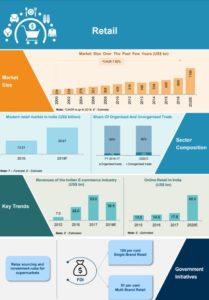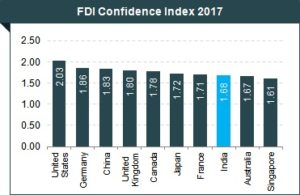Introduction
The Indian retail industry has emerged as one of the most dynamic and fast-paced industries due to the entry of several new players. It accounts for over 10 percent of the country’s Gross Domestic Product (GDP) and around 8 percent of the employment. India is the world’s fifth-largest global destination in the retail space. Indian Retail Industry has immense potential as India has the second largest population with affluent middle class, rapid urbanisation and solid growth of internet.
Market Size
India’s retail market is expected to increase by 60 per cent to reach US$ 1.1 trillion by 2020, on the back of factors like rising incomes and lifestyle changes by middle class and increased digital connectivity. While the overall retail market is expected to grow at 12 per cent per annum, modern trade would expand twice as fast at 20 per cent per annum and traditional trade at 10 per cent# . Indian retail market is divided into “Organized Retail Market contributes 93 per cent of the total sector and “Unorganised Retail Market contributes the rest 7 percent of the sector.
India’s Business to Business (B2B) e-commerce market is expected to reach US$ 700 billion by 2020##. Online retail is expected to be at par with the physical stores in the next five years and has grown 23 per cent to $17.8 billion in 2017. India’s total potential of Business to Consumer (B2C) is estimated to be US$ 26 billion, of which $3 billion can be achieved in the next three years from 16 product categories, according to a study by Federation of Indian Chambers of Commerce and Industry (FICCI) and Indian Institute of Foreign Trade (IIFT). India is expected to become the world’s fastest growing e-commerce market, driven by robust investment in the sector and rapid increase in the number of internet users. Various agencies have high expectations about growth of Indian e-commerce markets. Indian e-commerce sales are expected to reach US$ 120 billion! by 2020 from US$ 30 billion in FY2016. Further, India’s e-commerce market is expected to reach US$ 220 billion in terms of gross merchandise value (GMV) and 530 million shoppers by 2025, led by faster speeds on reliable telecom networks, faster adoption of online services and better variety as well as convenience. India’s direct selling industry is expected to reach Rs 159.3 billion (US$ 2.5 billion) by 2021, if provided with a conducive environment through reforms and regulation.
India is expected to become the world’s third-largest consumer economy, reaching US$ 400 billion in consumption by 2025.
Luxury market of India is expected to grow to US$ 30 billion by the end of 2018 from US$ 23.8 billion 2017 supported by growing exposure of international brands amongst Indian youth and higher purchasing power of the upper class in tier 2 and 3 cities, according to Assocham.
The size of modern retail in India is expected to reach US$ 11.25 billion in 2019 from US$ 70.45 billion in 2016.
- India has occupied a remarkable position in global retail rankings; the country has high market potential, low economic risk and moderate political risk
- India is expected to become the world’s third-largest consumer economy, reaching US$ 400 billion in consumption by 2025, according to a study by Boston Consulting Group
- India is ranked first in the Global Retail Development Index 2017, backed by rising middle class and rapidly growing consumer spending
- India’s retail market witnessed investments worth US$800 million by Private Equity (PE) firms and wealth funds in 2017.
- Department of Industrial Policy and Promotion (DIPP) approved three foreign direct investments (FDI), Mountain Trail Food, Kohler India Corporation, and Merlin Entertainments India in the single brand retail sector.
Note: FDI – Foreign Direct Investment
Source: AT Kearney 2017 FDI Confidence Index
Investment Scenario
The Indian retail trading has received Foreign Direct Investment (FDI) equity inflows totalling US$ 1.14 billion during April 2000–December 2017, according to the Department of Industrial Policies and Promotion (DIPP). With the rising need for consumer goods in different sectors including consumer electronics and home appliances, many companies have invested in the Indian retail space in the past few months.
- Department of Industrial Policy and Promotion (DIPP) approved three foreign direct investments (FDI), Mountain Trail Food, Kohler India Corporation, and Merlin Entertainments India in the single brand retail sector and two FDI proposals of over Rs 400 crore (US$ 62.45 million) within the retail sector.
- With 2017 being a successful year for herbal-ayurvedic brands, new Indian organic labels in hair care, cosmetics, food and apparel are belting up to carve an organic niche in the growing herbal segment.
- Investments by private equity firms and wealth firms in Indian retail sector reached US$ 800 million in 2017
- India’s retail sector attracted Rs 9.5 billion (US$ 147.40 million) investments in FY18, at a growth rate of 35 per cent year-on-year from Rs 7 billion (US$ 104.34 million) in FY17.
Government Initiatives
The Government of India has taken various initiatives to improve the retail industry in India. Some of them are listed below:
- The Government of India may change the Foreign Direct Investment (FDI) rules in food processing, in a bid to permit e-commerce companies and foreign retailers to sell Made in India consumer products.
- Government of India has allowed 100 per cent Foreign Direct Investment (FDI) in online retail of goods and services through the automatic route, thereby providing clarity on the existing businesses of e-commerce companies operating in India.
Road Ahead
E-commerce is expanding steadily in the country. Customers have the ever increasing choice of products at the lowest rates. E-commerce is probably creating the biggest revolution in the retail industry, and this trend would continue in the years to come. Retailers should leverage the digital retail channels (e-commerce), which would enable them to spend less money on real estate while reaching out to more customers in tier-2 and tier-3 cities.
Both organised and unorganised retail companies have to work together to ensure better prospects for the overall retail industry, while generating new benefits for their customers. Nevertheless, the long-term outlook for the industry is positive, supported by rising incomes, favourable demographics, entry of foreign players, and increasing urbanisation.
Exchange Rate Used: INR 1 = US$ 0.016 as on FY2018.

Note: FMCG – Fast Moving Consumer Goods
Source: Aranca Research
References: Media Reports, Press Releases, Deloitte report, Department of Industrial Policy and Promotion website, Union Budget 2017–18
Note:- according to a joint ASSOCHAM-Forrester study paper,@ – as per Bank of America Merrill Lynch (BofA-ML) report., # – as per a report titled ‘Retail 2020: Retrospect, Reinvent, Rewrite’ by The Boston Consulting Group and Retailers Association of India,## – as per Confederation of Indian Industry (CII) and Deloitte Touche Tohmatsu India LLP
Disclaimer: This information has been collected through secondary research and BrandFace is not responsible for any errors in the same



